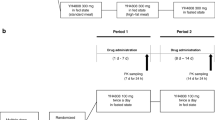Summary
The pharmacokinetics of single intravenous and oral doses of L-carnitine 2 and 6 g was studied in 6 healthy subjects on a low-carnitine diet. Carnitine was more rapidly eliminated from plasma after the 6 g dose. Comparing the doses, the t1/2β of the elimination phase (β) was 6.5 h vs 3.9 h, the elimination constant 0.40 vs 0.50 h−1 and the plasma carnitine clearance was 5.4 vs 6.11 · h−1 for the 2 g and 6 g doses, respectively, showing dose-related elimination. Saturable kinetics were not found. The apparent volumes of distribution after the two doses were not significantly different and were of the same order as the total body water. Urinary recoveries of the 2 g and 6 g doses were 70% and 82%, respectively, during the first 24 h. Following the oral doses, there was no significant difference between the areas under the plasma carnitine concentration-time curves. Urinary recovery was 8% and 4% for the 2 g and 6 g doses during the first 24 h. Oral bioavailability was 16% for the 2 g dose and 5% for the 6 g dose. The results suggest that the mucosal absorption of carnitine was already saturated by the 2 g dose.
Similar content being viewed by others
References
Bremer J (1983) Carnitine — metabolism and functions. Physiol Rev 63: 1420–1480
Rebouche CJ, Engel AG (1984) Kinetic compartmental analysis of carnitine metabolism in the human carnitine deficiency syndromes: evidence for alterations in tissue carnitine transport. J Clin Invest 73: 857–867
Bieber LL, Emaus R, Valkner K, Farrel S (1982) Possible functions of short-chain and medium-chain carnitine acyltransferases. Fed Proc 41: 2858–2862
Engel AG, Rebouche CJ (1984) Carnitine metabolism and inborn errors. J Inherited Metab Dis 1 [Suppl]: 38–43
Welling PG, Thomsen JH, Shug AL, Tse FLS (1979) Pharmacokinetics of l-carnitine in man following intravenous infusion of dl-carnitine. Int J Clin Pharm Biopharm 70: 56–60
Cederblad G (1984) Fat metabolism following an intravenous bolus dose of a fat emulsion and carnitine. Clin Physiol 4: 159–168
Bach AC, Schirardin H, Sihr M-O, Storck D (1983) Free and total carnitine in human serum after oral ingestion ofl-carnitine. Diabete Metab 9: 121–124
Frohlich J, Seccombe DW, Hahn P, Dodek P, Hynie I (1978) Effect of fasting on free and esterified carnitine levels in human serum and urine: Correlation with serum levels of free fatty acids and β-hydroxybutyrate. Metabolism 27: 555–561
Gross CJ, Henderson LM (1984) Absorption ofd- andl-carnitine by the intestine and kidney tubule in the rat. Biochim Biophys Acta 772: 209–219
Rudman D, Sewell CW, Ansley JD (1977) Deficiency of carnitine in cachectic cirrhotic patients. J Clin Invest 60: 716–723
Naftalin L, Mitchell LR (1958) A new urine preservative. Clin Chim Acta 3: 197–199
Cederblad G, Lindstedt (1972) A method for the determination of carnitine in the picomole range. Clin Chim Acta 37: 235–243
Cederblad G, Finnström O, Mårtensson J (1982) Urinary excretion of carnitine and its derivatives in newborns. Biochem Med 27: 260–265
Cederblad G, Harper P, Lindgren K (1986) Spectrophotometry of carnitine in biological fluids and tissues with Cobas Bio centrifugal analyzer. Clin Chem 32: 342–346
Cederblad G, Floderus A, Karlsson KE (1976) A computer program for an open two compartment system distinguishing three models. Acta Physiol Scand 96: 471–477
Sjöqvist F, Borgå O, Orme ML'E (1986) Fundamentals of clinical pharmacology. In: Avery GS (ed) Drug treatment, 3rd edn. ADIS Press, New Zeeland
Cederblad G, Fåhraeus L, Lindgren K (1986) Plasma carnitine and renal-carnitine clearance during pregnancy. Am J Clin Nutr 44: 379–383
Borum PR (1983) Role of carnitine supplementation in clinical nutrition. In Johnston IDA (ed) Advances in clinical nutrition. MTP Press, Lancaster, Boston, the Hague
Seim H, Schultze J, Strack E (1985) Catabolic pathways for high-dosedl (−)- ord (+) -carnitine in germ-free rats? Biol Chem Hoppe-Seyler 366: 1017–1021
Rebouche C, Mack DL, Edmonson PF (1984)l-Carnitine dissimilation in the gastrointestinal tract of the rat. Biochemistry 23: 6422–6426
Gudjonsson H, Li BUK, Shug AL, Olsen WA (1985) In vivo studies of intestinal carnitine absorption in rats. Gastroent 88: 1880–1887
Gudjonsson H, Li BUK, Shug AL, Olsen WA (1985) Studies of carnitine metabolism in relation to intestinal absorption. Am J Physiol 248: G313-G319
Author information
Authors and Affiliations
Rights and permissions
About this article
Cite this article
Harper, P., Elwin, C.E. & Cederblad, G. Pharmacokinetics of bolus intravenous and oral doses of L-carnitine in healthy subjects. Eur J Clin Pharmacol 35, 69–75 (1988). https://doi.org/10.1007/BF00555510
Received:
Accepted:
Issue Date:
DOI: https://doi.org/10.1007/BF00555510




